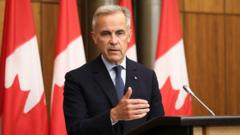In a significant move to reshape trade dynamics, Canadian Prime Minister Mark Carney announced on Friday that Canada will reduce several of its multi-billion dollar retaliatory tariffs on American imports, with certain exceptions in the automotive and steel sectors. This announcement follows Carney's recent phone conversation with US President Donald Trump, which took place shortly after both nations failed to reach a trade agreement by a self-imposed deadline.
Canada had previously implemented a 25% tariff on approximately C$30bn ($21.7bn) worth of US products, including a variety of goods from orange juice to washing machines, as retaliation against America's own tariffs—a review now indicates a 35% markup on goods not aligned with the current free trade agreement. Carney emphasized that Canada's new stance will allow it to align its tariffs with the US-Mexico-Canada Agreement (USMCA), effectively re-establishing free trade for most items exchanged between the countries. This adjustment is expected to take effect on September 1.
The move has been acknowledged positively by the White House, describing it as a long-anticipated step forward in trade relations with Canada. While Canada navigates its trade relationships, polling indicates that many Canadians favor maintaining retaliatory tariffs, reflecting the complexities of the nation’s trade negotiations.
Carney, who has adopted a robust negotiating position since assuming office, articulated that Canada’s existing tariff arrangements still provide a comparative advantage. The effective tariff rate on Canadian goods is around 5.6%, which is significantly lower than the global average of 16% for other nations. The focus for Canada remains on advancing discussions surrounding essential sectors like autos, steel, aluminium, and lumber as the review of the USMCA approaches next year.
Since re-entering the White House earlier this year, President Trump has initiated a broader trade agenda, asserting tariffs on numerous countries in efforts deemed beneficial to the US economy. The ongoing dialogue between the two countries reflects a tenuous balance as both find common ground amidst escalating international trade challenges.
Canada had previously implemented a 25% tariff on approximately C$30bn ($21.7bn) worth of US products, including a variety of goods from orange juice to washing machines, as retaliation against America's own tariffs—a review now indicates a 35% markup on goods not aligned with the current free trade agreement. Carney emphasized that Canada's new stance will allow it to align its tariffs with the US-Mexico-Canada Agreement (USMCA), effectively re-establishing free trade for most items exchanged between the countries. This adjustment is expected to take effect on September 1.
The move has been acknowledged positively by the White House, describing it as a long-anticipated step forward in trade relations with Canada. While Canada navigates its trade relationships, polling indicates that many Canadians favor maintaining retaliatory tariffs, reflecting the complexities of the nation’s trade negotiations.
Carney, who has adopted a robust negotiating position since assuming office, articulated that Canada’s existing tariff arrangements still provide a comparative advantage. The effective tariff rate on Canadian goods is around 5.6%, which is significantly lower than the global average of 16% for other nations. The focus for Canada remains on advancing discussions surrounding essential sectors like autos, steel, aluminium, and lumber as the review of the USMCA approaches next year.
Since re-entering the White House earlier this year, President Trump has initiated a broader trade agenda, asserting tariffs on numerous countries in efforts deemed beneficial to the US economy. The ongoing dialogue between the two countries reflects a tenuous balance as both find common ground amidst escalating international trade challenges.





















